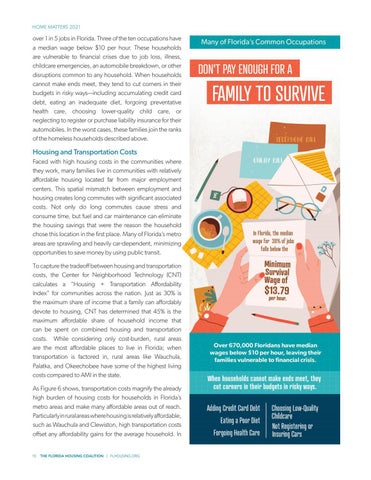HOME MATTERS 2021
over 1 in 5 jobs in Florida. Three of the ten occupations have a median wage below $10 per hour. These households are vulnerable to financial crises due to job loss, illness, childcare emergencies, an automobile breakdown, or other disruptions common to any household. When households cannot make ends meet, they tend to cut corners in their budgets in risky ways—including accumulating credit card debt, eating an inadequate diet, forgoing preventative health care, choosing lower-quality child care, or neglecting to register or purchase liability insurance for their automobiles. In the worst cases, these families join the ranks of the homeless households described above.
Housing and Transportation Costs Faced with high housing costs in the communities where they work, many families live in communities with relatively affordable housing located far from major employment centers. This spatial mismatch between employment and housing creates long commutes with significant associated costs. Not only do long commutes cause stress and consume time, but fuel and car maintenance can eliminate the housing savings that were the reason the household chose this location in the first place. Many of Florida’s metro areas are sprawling and heavily car-dependent, minimizing opportunities to save money by using public transit. To capture the tradeoff between housing and transportation costs, the Center for Neighborhood Technology (CNT) calculates a “Housing + Transportation Affordability Index” for communities across the nation. Just as 30% is the maximum share of income that a family can affordably devote to housing, CNT has determined that 45% is the maximum affordable share of household income that can be spent on combined housing and transportation costs. While considering only cost-burden, rural areas are the most affordable places to live in Florida; when transportation is factored in, rural areas like Wauchula, Palatka, and Okeechobee have some of the highest living costs compared to AMI in the state. As Figure 6 shows, transportation costs magnify the already high burden of housing costs for households in Florida’s metro areas and make many affordable areas out of reach. Particularly in rural areas where housing is relatively affordable, such as Wauchula and Clewiston, high transportation costs offset any affordability gains for the average household. In
10
THE FLORIDA HOUSING COALITION | FLHOUSING.ORG












